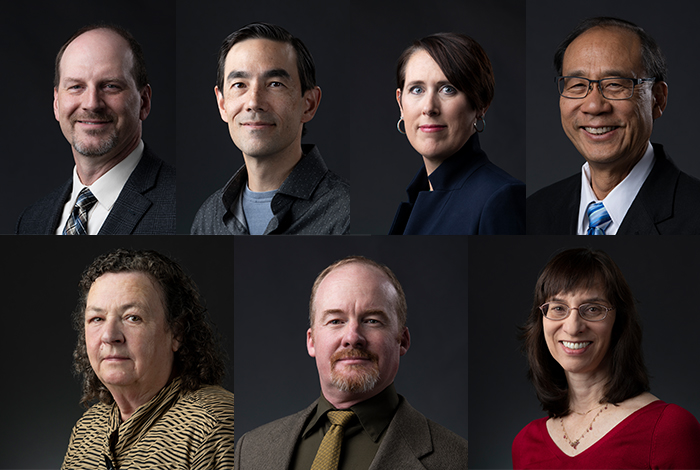LOS ALAMOS, N.M., Oct. 16, 2019—Los Alamos National Laboratory scientists Brian Albright, Patrick Chain, Dana Dattelbaum, Michael Hamada, Anna Hayes-Sterbenz, Michael Prime and Laura Smilowitz are being honored as 2019 Laboratory fellows.
“Los Alamos National Laboratory Fellows are the best of our scientists and engineers. This year’s fellows are leaders in their fields who have made exceptional contributions not only to the Laboratory’s national security mission, but also to the broader scientific community,” said Thom Mason, director of Los Alamos National Laboratory. “It’s an honor to recognize these innovative researchers in such distinct, important fields.”
Brian Albright, of Primary Physics, is an expert in plasma physics with diverse and high-impact contributions in both open science and nuclear weapons. His breakthrough research on laser-driven ion acceleration has led to record-setting performance that is enabling new applications, while his novel contributions to boost physics are impacting the ability to assess and certify the current and future stockpile.
Patrick Chain, of Biosecurity and Public Health, is an authority in environmental microbiology, infectious disease research and bioinformatics applied to defense, health and agriculture. He investigates biothreat diversity, microbial evolution and the relationship between non-pathogen near neighbors. He also has developed detection and intervention approaches leading to key national laboratory participation in genomics. Chain also developed the genome analysis/bioinformatics platform EDGE, making genome data standardized and accessible; EDGE is widely used internationally.
Dana Dattelbaum, of Explosive Science and Shock Physics, is an authority on and major contributor to the base shock physics underpinning the weapons program at Los Alamos National Laboratory. She has designed and executed numerous fundamental experiments leading to the understanding of initiation, reaction and detonation of explosives. She plays an integral role in establishing and understanding the properties of high explosives and soft materials essential to National Nuclear Security Administration and Department of Defense programs.
Michael Hamada, of Statistical Sciences, is an authority on statistical methods and applications, especially Bayesian methods. He developed and applied PowerFactoRE, a suite of tools to identify and diagnose reliability, transforming operations at Procter and Gamble, saving them nearly $1 billion. Hamada enabled the weapons program to make reliability forecasts when the data are sparse, allowing NNSA to accept metrics to assess the effectiveness of surveillance. He also made contributions to pit manufacturing, annual reliability assessments, resolving significant findings and life extension programs. He is the author of two definitive books on statistics and its use.
Anna Hayes-Sterbenz, of Nuclear and Particle Physics, is a nuclear physics theorist advancing theory by supporting basic science and weapons programs. She is an expert on nuclear structure and reactions and an authority on analysis of accelerator and reactor-based neutrino experiments. She was the first to use reaction-in-flight neutron production to diagnose mix in inertial confinement fusion; she supports the Lab’s global security mission through development of methods to diagnose reactor operations that can detect proliferation activity.
Michael Prime, of Advanced Engineering Analysis, is a leading expert in modelling the strength and damage of metals under extreme conditions. He is instrumental to the design, simulation, manufacture, fielding and interpretation of subcritical experiments used to define modern stockpile stewardship in the post-underground test era. Prime is the sole inventor of the contour method to measure residual stress that is universally adopted by several major industries worldwide.
Laura Smilowitz, of Physical Chemistry and Applied Spectroscopy, is an expert in the dynamic/thermal response of energetic materials and high-speed diagnostics, and is also an authority in experiments applied to key materials relevant to nuclear weapons, conventional defense and global security. She developed laser pulsing of high explosives in synchronicity with proton radiography to accelerate ignition and enable high-resolution radiography of subsonic thermal explosions. Smilowitz is the designer, driver and principal investigator for high-visibility, thermal explosion experiments, giving new capability to understand and model those explosions.
About the Laboratory Fellows
The Fellow appointment at Los Alamos is an honor bestowed in recognition of outstanding achievement in science and/or engineering, recognizing the full breadth of Laboratory accomplishment from basic research to applied missions. Nominations are assessed on the basis of three criteria:
- Sustained, high-level achievements in programs of importance to the Laboratory
- A fundamental or important discovery that has led to widespread use
- Having become a recognized authority in the field
About Los Alamos National Laboratory
Los Alamos National Laboratory, a multidisciplinary research institution engaged in strategic science on behalf of national security, is operated by Triad, a public service oriented, national security science organization equally owned by its three founding members: Battelle Memorial Institute (Battelle), The Texas A&M University System (TAMUS), and The Regents of the University of California (UC) for the Department of Energy’s National Nuclear Security Administration.
Los Alamos enhances national security by ensuring the safety and reliability of the U.S. nuclear stockpile, developing technologies to reduce threats from weapons of mass destruction, and solving problems related to energy, environment, infrastructure, health, and global security concerns.
Original post https://alertarticles.info
